2016 MERCEDES-BENZ G-CLASS SUV tow
[x] Cancel search: towPage 203 of 261
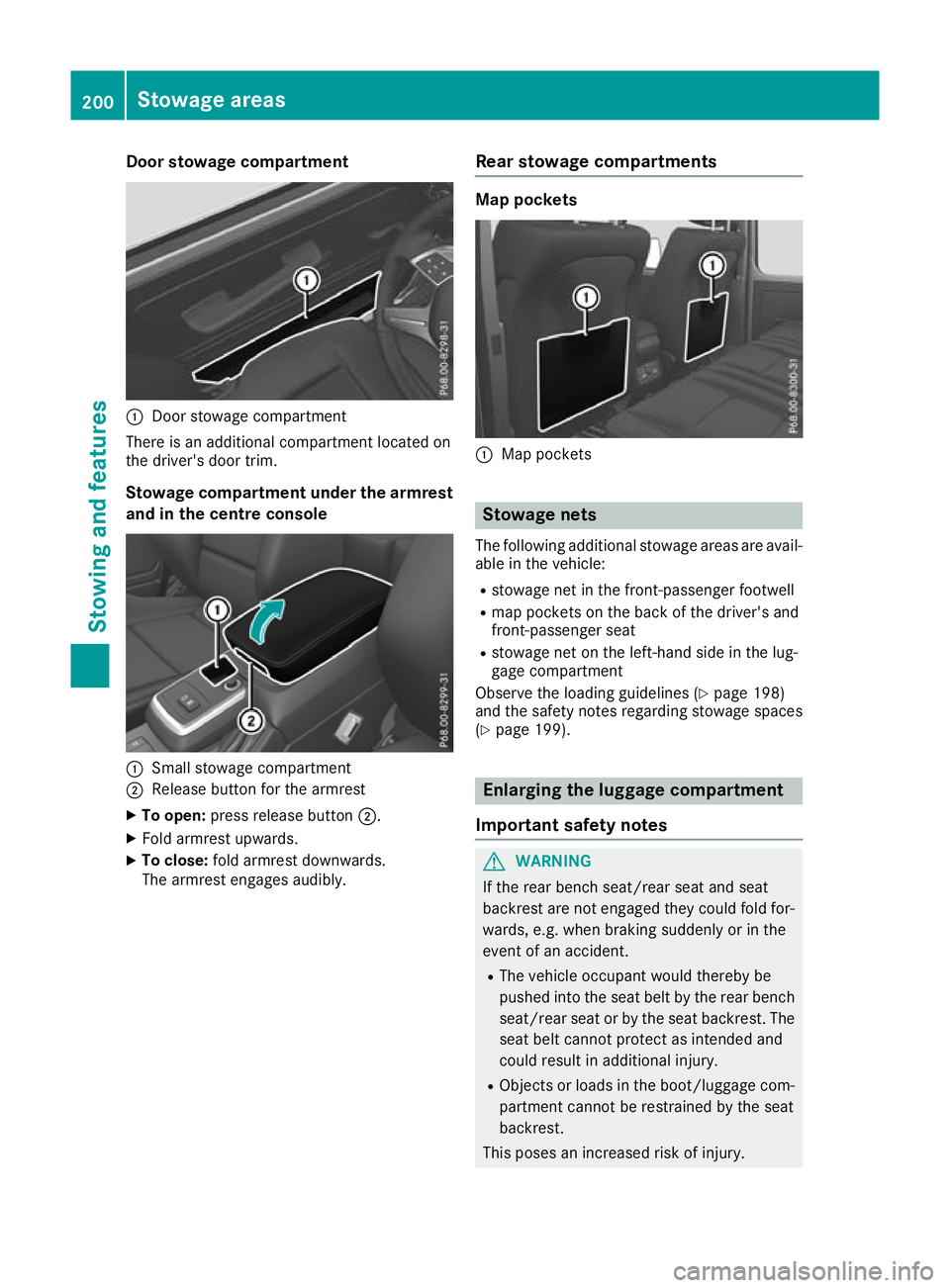
Door stowag
ecompartment :
Door stowage compartment
There is an additiona lcompartment locate don
the driver's door trim.
Stowage compartment unde rthe armrest
and in the centre console :
Smal lstowag ecompartment
; Releas ebutton for the armrest
X To open: press release button ;.
X Fol da rmres tupwar ds.
X To close: folda rmres tdownwards.
The armres tengages audibly. Rear stowag
ecom partments Map pockets
:
Map pockets Stowag
enets
The following additional stowage areas are avail-
able in the vehicle:
R stowage net in the front-passenger footwell
R map pocketsont he back of the driver's and
front-passenger seat
R stowage net on the left-hand side in the lug-
gage compartment
Observe the loading guidelines (Y page 198)
and the safety notes regarding stowage spaces
(Y page 199). Enla
rging th eluggage compartment
Important safety notes G
WARNING
If th erear bench seat/rea rseat and seat
backrest are not engaged they coul dfold for-
wards, e.g. when braking suddenly or in the
event of an accident.
R The vehicl eoccupant would thereby be
pushed into the seat beltb ythe rear bench
seat/rea rseat or by the seat backrest. The
seat beltc annot protect as intended and
coul dresult in additiona linjury.
R Objects or loads in the boot/luggag ecom-
partment cannot be restrained by the seat
backrest.
This poses an increased risk of injury. 200
Stowage areasStowing and features
Page 204 of 261
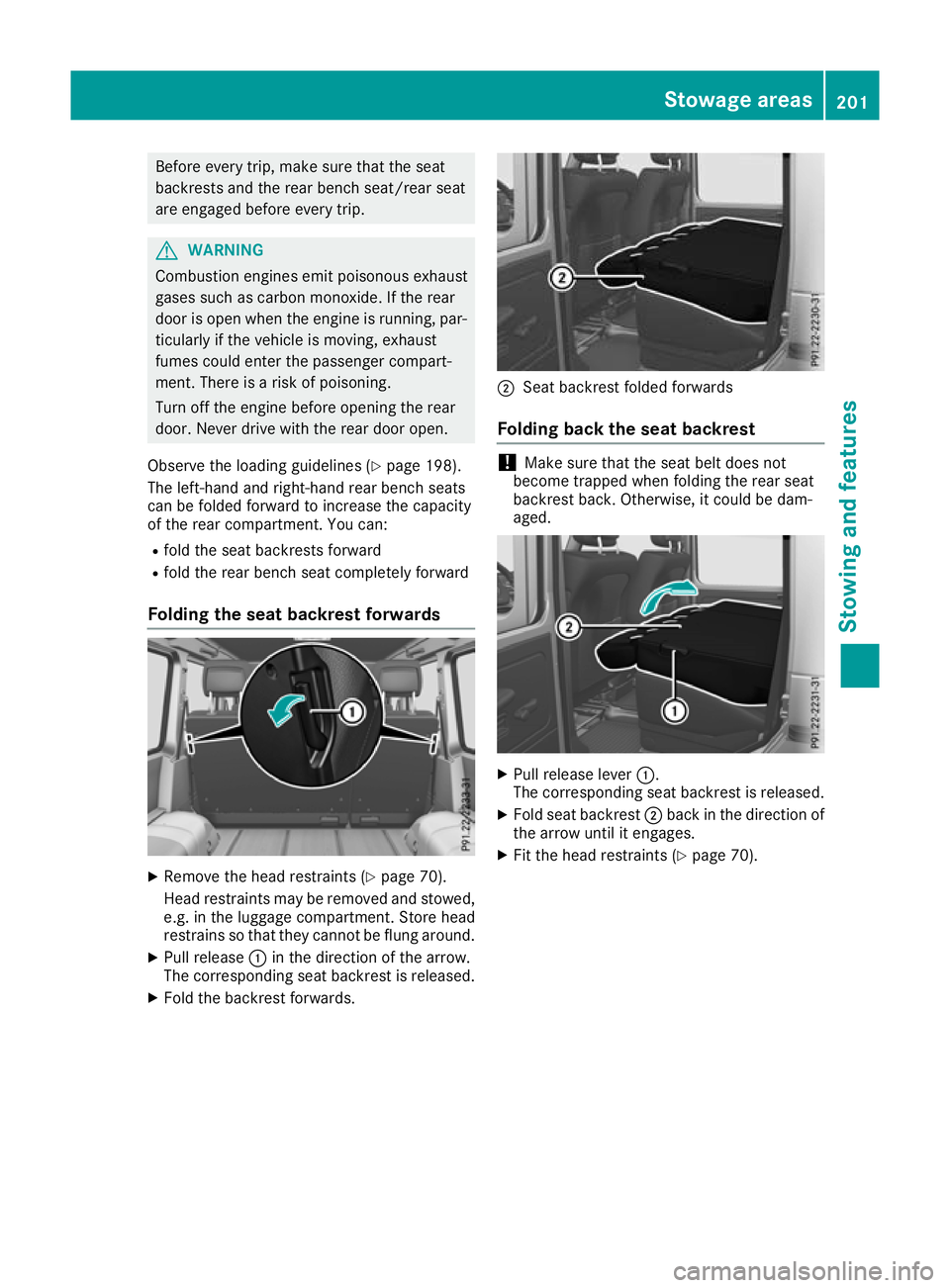
Befor
eevery trip ,make sur ethat the seat
backrests and the rea rbench seat/rea rseat
are engaged before every trip. G
WARNING
Combustio nengines emit poisonous exhaust
gase ssuch as carbon monoxide .Ifthe rear
door is open when the engine is running, par- ticularly if the vehicl eismoving, exhaust
fumes coul denter the passenger compart-
ment. There is arisk of poisoning.
Turn off the engine before opening the rear
door. Never drive with the rear door open.
Observe the loading guidelines (Y page198).
The left-hand and right-hand rear bench seats
can be folde dforward to increas ethe capacity
of the rear compartment. You can:
R fold the seat backrests forward
R fold the rear bench seat completely forward
Folding the seat backrest forwards X
Remove the head restraints (Y page 70).
Head restraints ma yberemove dand stowed,
e.g. in th eluggag ecom partment. Store head
restrain ssothatthe yc anno tbeflungaround.
X Pull release :in th edirection of th earrow.
The corresponding seat backrest is released.
X Fold th ebackrest forwards. ;
Seat backres tfolded forwards
Folding bac kthe seat backrest !
Make sure that the seat belt does not
become trapped when folding the rear seat
backrest back .Otherwise, it could be dam-
aged. X
Pull release lever :.
The corresponding seat backrest is released.
X Fold seat backrest ;back in the direction of
the arrow until it engages.
X Fit the head restraints (Y page 70). Stowage areas
201Stowing and features Z
Page 205 of 261
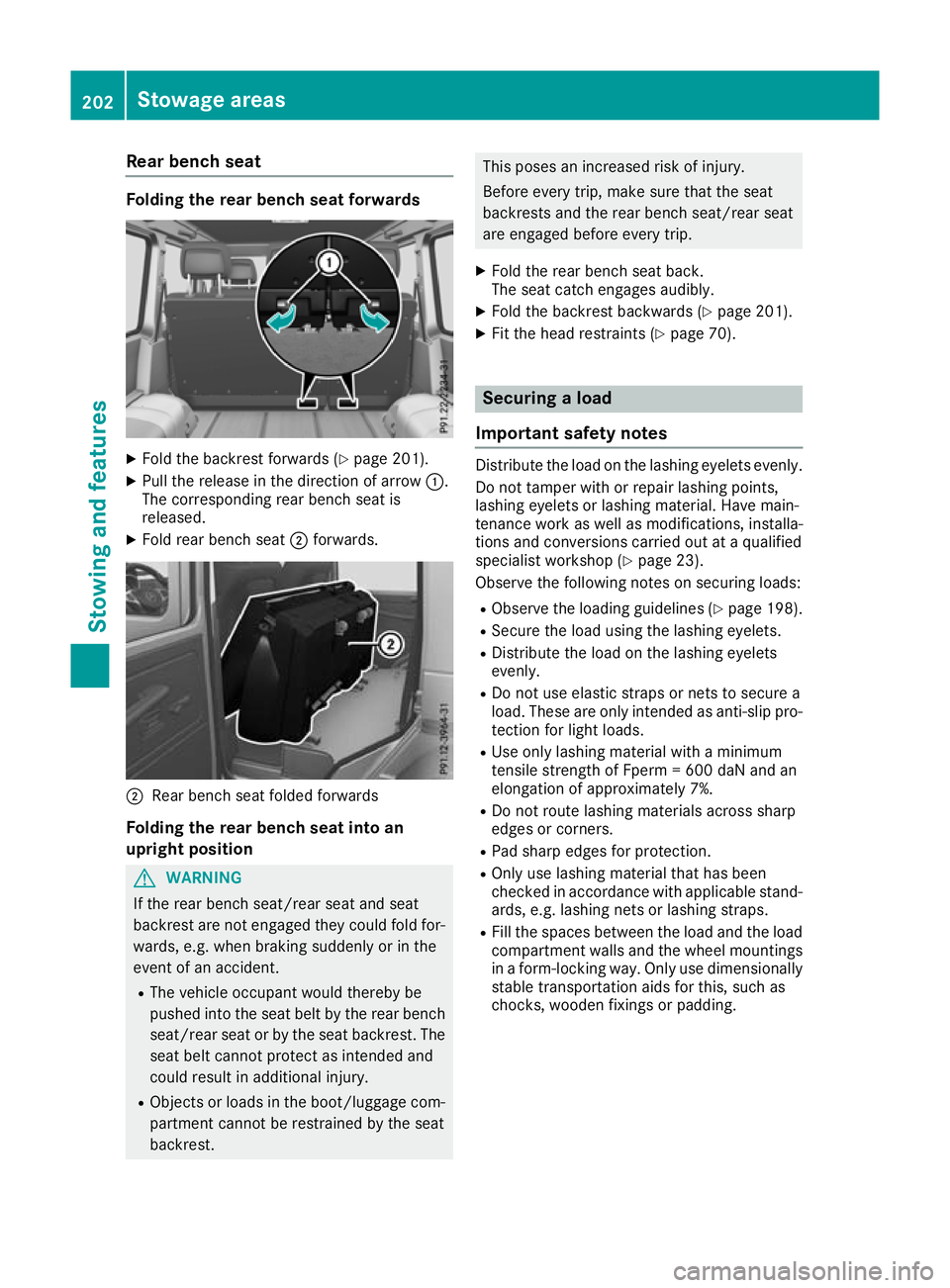
Rear benc
hseat Folding th
erearb ench seat forwards X
Fold th ebackrest forward s(Ypage 201).
X Pull the release in the directio nofarrow:.
The corresponding rea rbench sea tis
released.
X Fold rea rbench seat ;forwards. ;
Rear bench seat foldedf orwards
Folding th erearb ench sea tint oan
upright position G
WARNING
If th erear bench seat/rea rseat and seat
backrest are not engaged they coul dfold for-
wards, e.g. when braking suddenly or in the
event of an accident.
R The vehicl eoccupant would thereby be
pushed into the seat beltb ythe rear bench
seat/rea rseat or by the seat backrest. The
seat beltc annot protect as intended and
coul dresult in additiona linjury.
R Objects or loads in the boot/luggag ecom-
partment cannot be restrained by the seat
backrest. This poses an increased risk of injury.
Befor
eevery trip, make sure that the seat
backrest sand the rear bench seat/rear seat
are engaged before every trip.
X Fold the rear bench seat back.
The seat catche ngages audibly.
X Fold the backrest backwards (Y page 201).
X Fit the head restraints (Y page 70). Securing
aload
Important safety notes Distribute the load on the lashing eyelets evenly.
Do not tamper with or repair lashing points,
lashing eyelets or lashing mater ial.Hav emain-
tenance work as well as modifications, installa-
tions and conversions carrie doutataq uali fied
specialis tworkshop (Y page 23).
Observe the following note sonsecuring loads:
R Observe the loading guideline s(Ypage 198).
R Secure the load using the lashing eyelets.
R Distribute the load on the lashing eyelets
evenly.
R Do not us eelast ic straps or nets to secur ea
load .These ar eonlyi ntende dasanti-slip pro-
tection for light loads.
R Use onl ylas hing material with aminimum
tensil estrength of Fperm =600 da Nand an
elongation of approximately 7%.
R Do not route lashing material sacross sharp
edge sorc orners.
R Pa ds harp edge sfor protection.
R Onl yuselashing material tha thas been
checked in accordance with applicabl estand-
ards ,e.g.las hing nets or lashing straps.
R Fillthe space sbetween the load and the load
compartment wall sand the whee lmountings
in af orm-locking way. Onl yusedimensionally
stabl etransportatio naidsf or this, such as
chocks, wooden fixings or padding. 202
Stowag
eareasStowing and features
Page 206 of 261
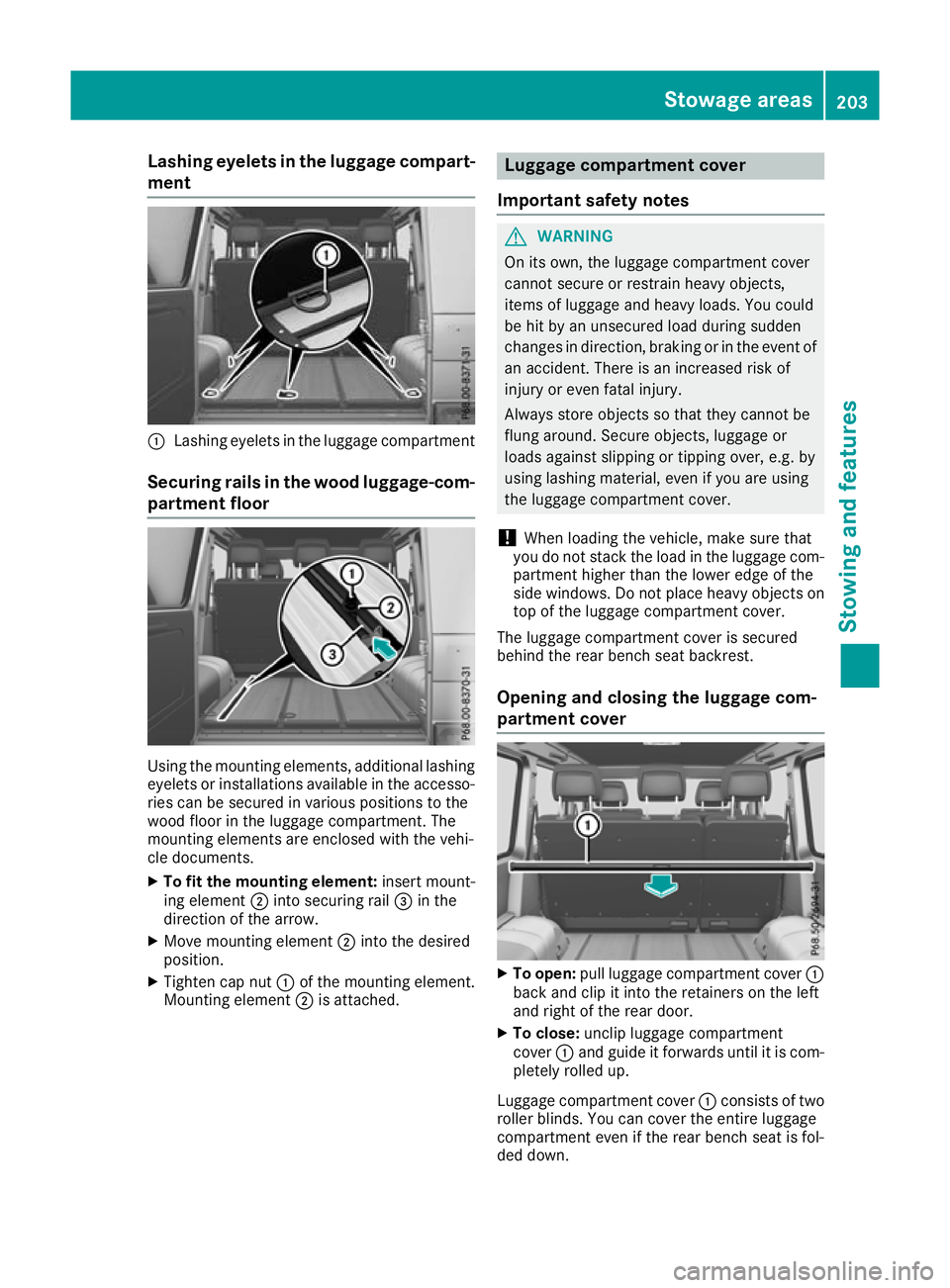
Lashing eyelet
sintheluggage compart-
ment :
Lashing eyelets in the luggage compartment
Securing rails in the wood luggage-com- partm ent floor Using the mounting elements, additional lashing
eyelets or installation savailable in the accesso-
ries can be secured in various positions to the
wood floor in the luggage compartment.T he
mounting elements are enclosed with the vehi-
cle documents.
X To fit the mounting element: insert mount-
ing element ;into securing rail =in the
direction of the arrow.
X Move mounting element ;into the desired
position.
X Tighten cap nut :of the mounting element.
Mounting element ;is attached. Luggage com
partment cover
Important safety notes G
WARNING
On its own ,the luggage compartment cover
cannot secure or restrai nheav yobjects,
items of luggage and heav yloads. You could
be hit by an unsecured loadd uring sudden
changes in direction, braking or in the event of an accident. There is an increased risk of
injury or even fatal injury.
Always store objects so that they cannot be
flung around. Secure objects, luggage or
loads against slipping or tipping over, e.g. by
using lashing material, even if you are using
the luggage compartment cover.
! When loading the vehicle, make sure that
you do not stack the loadint he luggage com-
partment higher than the lower edge of the
side windows. Do not place heav yobjects on
top of the luggage compartment cover.
The luggage compartment cover is secured
behind the rear bench seat backrest.
Opening and closing the luggage com-
partment cover X
To open: pull luggage compartment cover :
back and clip it into the retainers on the left
and right of the rear door.
X To close: unclip luggage compartment
cover :and guid eitforward suntilitisc om-
pletel yrolle dup.
Luggage compartment cover :consists of two
rolle rblinds. Yo ucan cove rthe entire luggage
compartment eve nifthe rea rbench sea tisf ol-
de dd own. Stowag
eareas
203Stowing and features Z
Page 207 of 261

Fitting/removing th
eluggage compart-
men tcover X
To remove: makesuret ha tlug gage compart-
ment cover ;is rolle dup.
X Slide catch :on both side stothe centre of
the vehicle.
X Swing luggage compartment cover ;
upwards.
X To fit: slidecatches :to the centre of the
vehicle.
X Insert luggage compartment cover ;into the
recesse softhe side trim panel.
X Press the left- and right-hand side of luggage
compartment cover ;downward unti lthe
luggage compartment cove rengages.
X Slide catches :toward sthe side trim panel. Safety net
Important safety notes G
WARNING
On its own, the safet ynet cannot secure or
restrai nheavy objects, items of luggage and
heavy loads. You coul dbehit by an unsecured
loadd uring sudden changes in direction,
braking or in the event of an accident. There is an increased risk of injury or even fatal injury.
Always store objects so that they cannot be
flung around. Secure objects, luggage or
loads against slipping or tipping over, e.g. by
using lashing material, even if you are using
the safety net.
It is important to use asafety net if you loadt he
vehicl ewith smal lobjects above the seat backr- ests
.For safety reasons, alway suseasafety net
when transporting aload.
Damaged safety netsc an no longer fulfil their
protective function and must be replaced. Visit a qualified specialist workshop.
Safet ynet without luggage compart-
ment enlargement X
Open the rear door.
X Fold the rear bench seat forward, without
folding the seat backrest forward beforehand
(Y page 202).
X Hook safety net :into retainers ;on both
sides. X
Tensionin gbuckles =of tensioning
straps ?must point in the direction of travel.
X Set tensioning straps ?to the length for
lashing eyelets Busing tensioning buckles
=. 204
Stowage areasStowing and features
Page 208 of 261
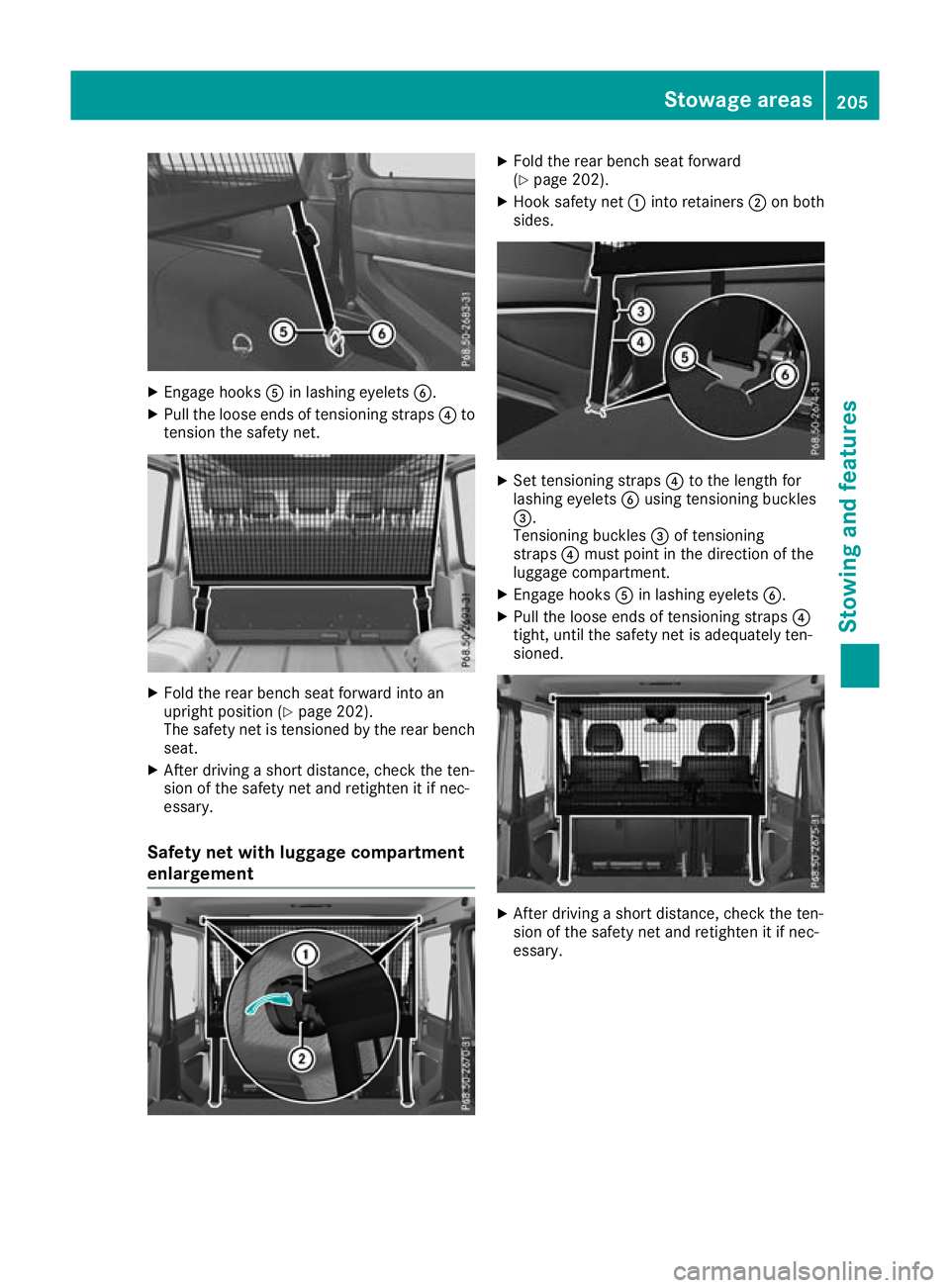
X
Engage hooks Ain lashing eyelets B.
X Pull the loose end softensioning straps ?to
tensio nthe safety net. X
Fold the rea rbench sea tforward into an
upright positio n(Ypage 202).
The safety net is tensioned by the rea rbench
seat.
X After driving ashor tdistance, check the ten-
sio noft he safety net and retighten it if nec-
essary.
Safety ne twithl uggag ecom partment
enlargement X
Fold the rea rbench sea tforward
(Y page 202).
X Hook safety net :into retainers ;on both
sides. X
Set tensioning straps ?to the length for
lashing eyelets Busing tensioning buckles
=.
Tensioning buckles =of tensioning
straps ?mus tpoint in the direction of the
luggage compartment.
X Engag ehooks Ain lashing eyelets B.
X Pull the loose ends of tensioning straps ?
tight, unti lthe safety net is adequately ten-
sioned. X
After driving ashort distance, check the ten-
sion of the safety net and retighte nitifnec-
essary. Stowag
eareas
205Stowing and features Z
Page 209 of 261
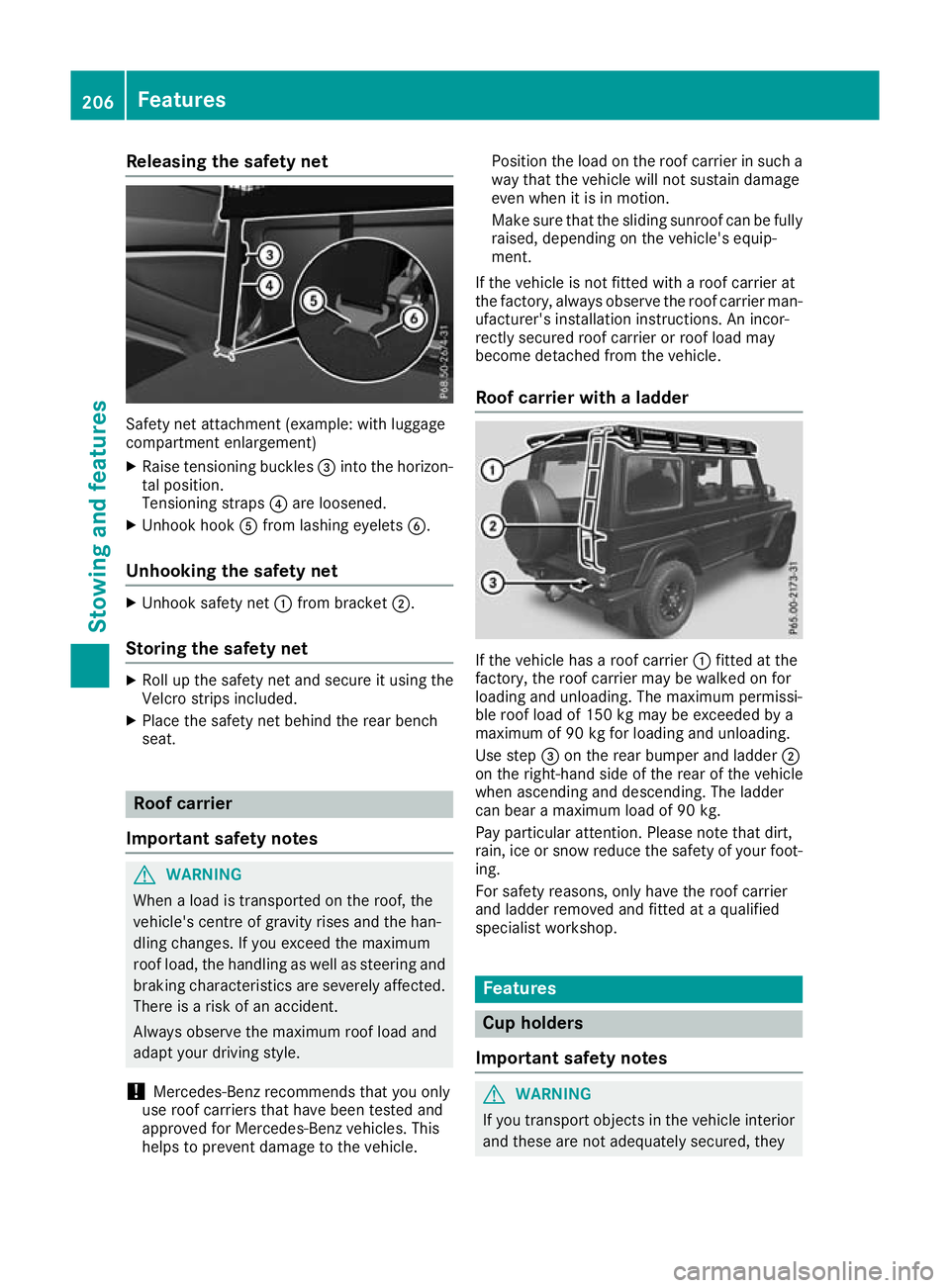
Releasin
gthe safety net Safety net attachment (example
:withl ug gage
compartment enlargement)
X Raise tensioning buckles =into the horizon-
tal position.
Tensioning straps ?are loosened.
X Unhook hook Afrom lashing eyelets B.
Unhookin gthe safety net X
Unhook safety net :from bracket ;.
Storing the safety net X
Roll up the safety net an dsecure it usin gthe
Velcro strips included.
X Plac ethe safet ynetbehind th erear bench
seat. Roof carrier
Importan tsafety notes G
WARNING
When aloa dist ransported on the roof, the
vehicle's centre of gravity rises and the han-
dling changes .Ifyou exceed the maximum
roof load, the handling as wellass teering and
braking characteristics are severely affected.
There is arisk of an accident.
Always observe the maximu mroof loada nd
adapt yourd riving style.
! Mercedes-Benz recommends that you only
use roof carriers that have been tested and
approved for Mercedes-Benz vehicles. This
help stop revent damage to the vehicle. Position the load on the roof carrier in such a
way that the vehicle will not sustain damage
even when it is in motion.
Make sure that the sliding sunroof can be fully
raised, dependin gonthe vehicle's equip-
ment.
If the vehicle is not fitted with aroof carrier at
the factory, alway sobserve the roof carrier man-
ufacturer's installation instructions. An incor-
rectly secured roof carrier or roof load may
become detached from the vehicle.
Roof carrier with aladder If the vehicl
ehasaroof carrier :fitted at the
factory, the roof carrier may be walked on for
loading and unloading. The maximum permissi-
ble roof load of 150 kg may be exceeded by a
maximum of 90 kg for loading and unloading.
Use step =on the rear bumpera nd ladder;
on the right-hand side of the rear of the vehicle
when ascending and descending. The ladder
can bear amaximum load of 90 kg.
Pay particular attention. Please note that dirt,
rain, ice or snow reduce the safety of yourf oot-
ing.
For safety reasons, only have the roof carrier
and ladder removed and fitted at aqualified
specialist workshop. Features
Cup holders
Important safety notes G
WARNING
If you transport objects in the vehicle interior and these are not adequately secured, they 206
FeaturesStowing and features
Page 210 of 261
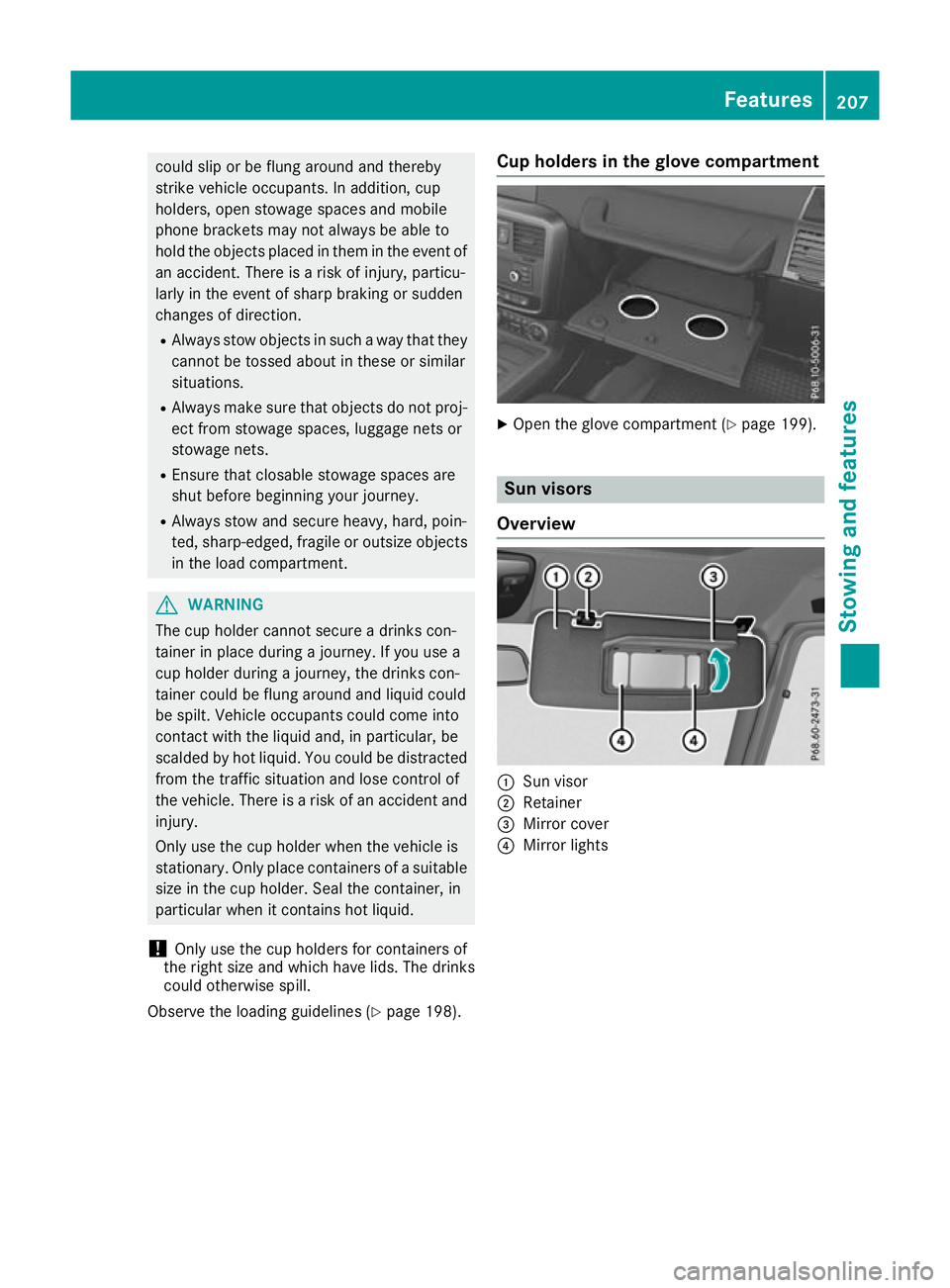
could sli
porbef lung around and thereby
strike vehicle occupants. In addition, cup
holders, ope nstowag espaces and mobile
phone brackets may not always be able to
hol dthe objects place dinthem in the event of
an accident. There is ariskofi njury, particu-
larly in the event of sharp braking or sudden
changes of direction.
R Alway sstow objects in such awaythat they
cannot be tosse dabout in these or similar
situations.
R Alway smake sure that objects do not proj-
ect from stowag espaces, luggage nets or
stowag enets.
R Ensure that closable stowag espaces are
shu tbefore beginning your journey.
R Alway sstow and secure heavy, hard, poin-
ted, sharp-edged, fragil eoroutsize objects
in the loa dcompartment. G
WARNING
The cup holder cannot secure adrinks con-
tainer in place during ajourney .Ifyou use a
cup holder during ajourney ,the drinks con-
tainer coul dbeflung around and liquid could
be spilt. Vehicle occupants coul dcome into
contact with the liquid and, in particular, be
scalded by hot liquid.Y ou couldbedistracted
from the traffic situation and lose control of
the vehicle. There is arisk of an accident and
injury.
Only use the cup holder when the vehicl eis
stationary. Only place containers of asuitable
size in the cup holder. Seal the container, in
particular when it contains hot liquid.
! Only use the cup holders for containers of
the right size and which have lids. The drinks
coul dotherwise spill.
Observe the loading guidelines (Y page198). Cu
ph olders in th eglove compartment X
Ope nthe glove compartment (Y page 199). Sun visors
Overview :
Sun visor
; Retainer
= Mirror cover
? Mirror lights Features
207Stowing and features Z